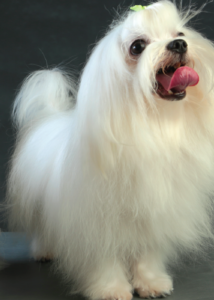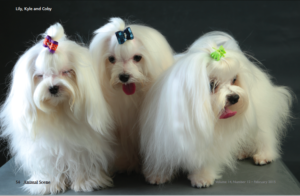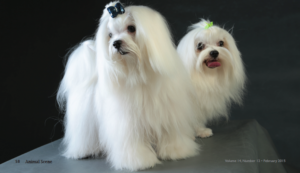The Maltese is a breed that offers love and companionship.
Photos by Rudy Liwanag
Jon Gumayagay
1. Can you give us a basic introduction to the Maltese, for an audience of animal fanciers who may be familiar with them as pets but who may have a few misconceptions about them? (For example, do they bite as often as small dogs are supposed to?)
The Maltese is a small dog breed, usually 5-7 lbs. that has long silky white hair. Its hair sheds lesser than fur and as such, this breed is better for people with asthma and allergies. Maltese dogs are really attention seekers. They love to be taken cared of, to be caressed, and they love playing, licking and kissing their master.
2. How did you get into raising/ breeding Maltese? What for you is their appeal?
Since childhood, I have had this enormous interest with dogs so when I entered college,
I studied Biology and was supposed to major in Zoology.
I have been attending dog social club meet ups and I’m really glad to meet great dog breeders and people in conformation shows. Here was where I’ve seen the Maltese and I am really fascinated and almost star struck by its looks. I love the white hair that almost flows like silk. I said it’s like looking at angels in the clouds. After that, I did a lot of research on the breed. That’s how I started and decided to have one.

3. What would you say to someone who is interested in keeping a Maltese as a pet? Can you give them things to consider before taking the plunge?
If you are planning to keep the Maltese as a pet, you better first do some research and gather ideas on the breed. I always say this in getting a dog: one should know their reason or intention for having one. Don’t buy or get dogs if you don’t have enough knowledge and understanding of the breed. Sad to say there are those who buy dogs who don’t understand their needs, ending up disappointed and the dogs neglected.
4. Who would make ideal owners for Maltese? Are they better suited to families with kids or to solo dwellers? What should their owners have (like a large yard, lots of time, access to exercise, etc.)?
Well, anyone could be an ideal owner of a Maltese. Solo dwellers and families with kids could be great owners too.
5. In your experience, what are the best things you’ve learned on how to care for the Maltese?
The Maltese is a great dog and the things that I have learned best from taking care of them are to have quality time, to play with them, and most importantly, proper nutrition. Never forget to keep track of their vaccinations, deworming and of course hygiene. Ensuring the best care for the Maltese will make them happy dogs.
6. What are the top misconceptions about Maltese that you would like to change?
The most common misconception that I frequently encounter is that the Maltese has a long coat that could cause exacerbation of asthma attacks and allergies in children. Well, the Maltese is known to be hypoallergenic. Another misconception is that the Maltese is not an intelligent dog. Dogs have innate intelligence that an owner would definitely see and realize later on.
7. What food is not good for the Maltese in particular?
Generally, those foods not good for dogs such as chocolates, alcohol, grapes, raisins, onions, garlic, salty food, and spoiled food. Too wet and saucy foods are also not good for them because of the possibility of staining their coat.

8. Can the Maltese be kept together in groups or should they be kept alone? Are they sociable with other pets such as other dog breeds, cats, etc.?
The Maltese is a very sociable dog. It will be happier playing with other dogs. 9. What kind of home does the Maltese need? A home that is clean, dry, well ventilated, well lit, and free of insects and injury-causing materials.
10. How did the Maltese come to the Philippines? How did they become popular?
Well, according to Foxstonemaltese.com, “Maltese descends from one of the most ancient dog breeds recorded history that originated around 6,000 B.C. Most of the literature said that the dog descended from a Spitz-type dog bred by the peoples of south central Europe particularly Italy.
The breed was then eventually propagated and distributed as an exotic article of trade from the ancient island trading center of Malta, hence the name, and from there migrated by caravans to the farthest reaches of the civilized world, including the Middle East, Tibet, China, the Philippines, and Japan.
11. What are the mistakes first-time owners of Maltese make, and why are they mistakes? How do you correct these?
Some mistakes that first- time owners make include the following:
(1.) Treating their pet like a child.
(2.) Wanting our dogs to do something but in the end it doesn’t listen to us.
(3.) Communication problems. Remember that in training and giving rules, it should be structured and a repetition of commands.
12. Why is it is called a Maltese?
The ancient Greeks and Romans believed that the dog originated from the Island of Malta, they called the breed the Melitaie Dog, Melitaie being the ancient name for Malta. (Source: foxtonemaltese.com)
13. What are the ideal characteristics of a healthy Maltese?
When the Maltese is active, eats well, drinks well, and does his usual daily activities. The Maltese has a shiny coat, intact and does not fall off easily. Your Maltese looks neat and does not stink. Of course, the dog does not look so limp and inactive.
14. What signs should you watch out for to know when a Maltese is sick? What illnesses and/or injuries are they prone to?
According to youpurebredpuppy.com, the most common problem in Maltese is INJURY. You must keep the Maltese under constant surveillance and leash/arm control. Too much can happen in the blink of an eye. Bone fractures or a concussion can occur from jumping off furniture, or falling or leaping from your arms, or being hit on the head by a thrown or falling object, or being stepped on.

The most common orthopaedic problem in Maltese is luxating patella (loose knees). Heart disease (especially patent ductusarteriosus and mitral valve disease) and epilepsy are becoming real concerns in the breed. Eye diseases in Maltese include corneal ulcers, tear duct disorders, eyelash abnormalities, glaucoma, and progressive retinal atrophy (PRA). Thyroid diseases are also a common problem with the Maltese.
Skin diseases include allergies (which cause itchy skin and can lead to pyoderma) and demodectic mange. Ear infections are common due to profuse hair in the ear canals. A serious neurological disease that occurs in Maltese more than any other breed is white shaker dog syndrome. Other health problems that occur regularly in Maltese are inherited deafness and hypoglycaemia in Maltese puppies. Maltese are prone to dental disease and harmless episodes of reverse sneezing. (Source: yourpurebredpuppy.com)
Fely Gatmaitan
1. Can you give us a basic introduction to the Maltese, for an audience of animal fanciers who may be familiar with them as pets but who may have a few misconceptions about them? (For example, do they bite as often as small dogs are supposed to?)
The Maltese is a lap dog that has long pure white silky coat. Having such characteristic makes people think that it’s not good for children and can trigger allergies. But the Maltese is a hypoallergenic dog and highly sociable which makes them a good companion for kids. It maintains its puppy-like attitude even when full grown and this appeals to me the most. Despite its size, the Maltese is fearless (in the sense that it’s not afraid of mingling with dogs larger than him) and can get along well with other dogs.
I’m pretty sure the Maltese would capture the heart of other dog fanciers because of its sweet nature, playfulness and intelligence. Yes, they have the puppy-like attitude throughout their lifespan, but they are very responsive and trainable.
2. How did you get into raising/breeding Maltese? What for you is their appeal?
I got into breeding Maltese because of fascination. I was enthralled by their appearance ―
long white coat and button-like eyes. But, it is their characteristics that I adore the most. Their sweet nature and puppy-like attitude are contagious, they make me feel young at heart. 🙂
3. What would you say to someone who is interested in keeping a Maltese as a pet? Can you give them things to consider before taking the plunge?
Maltese needs are basically the same with other dogs wherein commitment is a must. Keeping a Maltese as a pet is like adding a new member into your family ― a baby! There are questions that you have to ask yourself before getting a Maltese. Can you commit to give it its necessities: food, vitamins and other preventive treatments, medical check-up and grooming essentials all throughout their lifespan? ― That would mean a decade or more!
Aside from that, due to its long white silky coat (that is if you want to keep it that way), it is quite highmaintenance when it comes to grooming. It tends to mat and lose its shine when not brushed regularly. There are also products specifically made to maintain lustrous white coat and free it from stain.

4. Who would make ideal owners for the Maltese? Are they better suited to families with kids or to solo dwellers? What should their owners have (like a large yard, lots of time, access to exercise, etc.)?
Anybody who is a loving and responsible pet parent can have this breed. The Maltese can also get along well with children. However, supervision is advised. Maltese dogs don’t need much space due to their diminutive size but exercise and other mentally stimulating act ivities are highly recommended.
5. In your experience, what are the best things you’ve learned on how to care for Maltese?
I’ve learned that trimming the hair around their eyes could only make tear stains worse as it irritates the eyes. Cleaning or wiping and brushing with the help of whitening
products intended for Maltese coat are the best solutions.
6. What are the top misconceptions about Maltese that you would like to change?
One is that they are not good for people with allergies when they are in fact hypoallergenic.
7. What food is not good for the Maltese in particular?
There are plenty of foods to avoid, but it is basically the same with other dog breeds. “The American Maltese Association says that you should never feed your Maltese table scraps or cooked bones. . . Some of the common foods on this list are raisins, onions, chocolate, macadamia nuts, alcohol and avocados. Due to the small size of this breed, even a tiny amount of these toxic foods can kill a Maltese dog.” (http://www.petcarerx.com/article/the-diets-for-maltesedogs/730)
8. Can the Maltese be kept together in groups or should they be kept alone? Are they sociable with other pets such as other dog breeds, cats, etc.?
They are high-spirited and fearless which make them get along well with other dog breeds, even cats. I let my Maltese join other dog breeds in the yard during our so called “happy
hour” and everything goes well despite its playfulness.

9. What kind of home does the Maltese need?
Any kind of home that has an adequate living space― even an apartment and condominium will do.
10. How did the Maltese come to the Philippines? How did it become popular?
Historians said that the Maltese breed has been in the Philippine since 1841. A man known only as Mr. Lukey found a pair of Maltese in Manila and paid an extremely high price for this with the intention of giving it as a gift to the majesty in England. (Source: Fulda, J. (1995). p.9, Maltese: Everything about Purchase, Care, Nutrition, Breeding, Behavior,
and Training: Barron’s Educational Series.)
11. What are the mistakes first time owners of Maltese make, and why are they mistakes? How do you correct these?
That would be trimming the hair with tear stain around the eye. It will only irritate the eyes and make it worse.
12. Why is it is called a Maltese?
It is called Maltese because of its said origin in the Isle of Malta, a tiny island off the coast of Italy.
13. What are the ideal characteristics of a healthy Maltese?
A healthy Maltese is graceful, bold, and quick to respond.
14. What signs should you watch out for to know when a Maltese is sick? What illnesses and/or injuries are they prone to?
Here are some of the illnesses they are prone to:
• Portosystemic Shunt – a congenital problem that shows clinical signs by the time the dog is a young adult. Signs include poor weight gain, sensitivity to sedatives, head pressing, seizures, weakness, salivation, increased drinking and urinating.
• Luxated Patella- small dogs are prone to this.
• White Dog Shaker Syndrome- they can develop severe tremors for unexplained reasons.
The bizarre eye movements may get worse when they get too excited or stressed. (Source: Harrison, B. & Harrison, J. (1999). The essential Maltese. Wiley Publishing Inc. USA)
This appeared in Animal Scene’s February 2015 issue.






